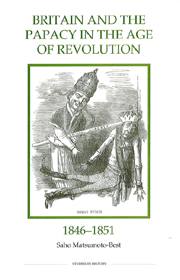Book contents
- Frontmatter
- Contents
- Dedication
- List of illustrations
- Acknowledgements
- Abbreviations
- Introduction
- 1 From 1815 to the election of Pius IX
- 2 The pope's liberal reforms, 1846–1847
- 3 The origins of the Minto mission
- 4 Britain and the 1848 revolution in Rome
- 5 Britain and the rise and fall of the Roman republic
- 6 The restoration of the Catholic hierarchy and anti-Catholicism in Britain
- Conclusion
- Bibliography
- Index
1 - From 1815 to the election of Pius IX
Published online by Cambridge University Press: 12 September 2012
- Frontmatter
- Contents
- Dedication
- List of illustrations
- Acknowledgements
- Abbreviations
- Introduction
- 1 From 1815 to the election of Pius IX
- 2 The pope's liberal reforms, 1846–1847
- 3 The origins of the Minto mission
- 4 Britain and the 1848 revolution in Rome
- 5 Britain and the rise and fall of the Roman republic
- 6 The restoration of the Catholic hierarchy and anti-Catholicism in Britain
- Conclusion
- Bibliography
- Index
Summary
The election of Pius IX as pope in July 1846 was a critical event in the development of Italian nationalism, for after years of inept government a champion of reform at last took charge of the most reactionary of the Italian states. The new pope inherited a state that was poorly administered, full of corruption and averse to social and political progress, and began in the first year of his pontificate to initiate policies that led to substantial change. This in turn led to growing interest in the pope in Britain and a desire to assist him in his mission.
However, before discussing Pius IX's election and the subsequent reforms, it is necessary to study the historical background to his succession to the papacy. In particular it is important to examine the circumstances within which the two principal proposals for reform were made prior to this date, namely the memorandum presented by the five European great powers in 1831, and the Manifesto di Rimini drawn up by Luigi Carlo Farini, the Romagnolo intellectual, in 1844. These memoranda are significant because, although Pope Gregory XVI largely ignored their contents, after July 1846 Pius IX attempted to act on their recommendations. This in turn helps to explain Britain's positive attitude towards the new pope: the British government was pleased that the principles behind the memorandum had finally been adopted.
The 1831 memorandum
In May 1814, after years of imprisonment on the orders of Napoleon, Pope Pius VII returned to Rome to reclaim his temporal power over the Papal States.
- Type
- Chapter
- Information
- Publisher: Boydell & BrewerPrint publication year: 2003



